Between August 18th and September 18th, 2017, one hurricane after another ravaged the Caribbean. First Hurricane Harvey, then Irma, Jose, and finally Maria slammed into many of the 28 Caribbean island nations. Puerto Rico, Cuba, Barbados, Antigua and Barbuda, St. Martin and Saint Barthélemy, Anguilla, the Leeward Islands, Turks and Caicos, the Dominican Republic and Haiti, the Virgin Islands, and Guadeloupe were all in the crosshairs. Hurricanes Irma and Maria were two of the strongest storms to hit the region in recorded history, each reaching an astounding category-5 status along their path. In addition to the destruction wrought on homes and businesses, the month of storms damaged museum buildings and left widespread power outages in their wake, retarding post-storm recovery efforts and further endangering museum collections.
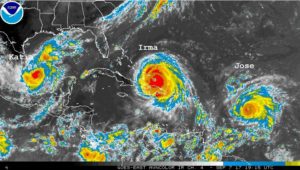
By US NOAA [Public domain], via Wikimedia Commons
After fire and flood, heat and humidity pose the greatest threats to art and artifacts in collections. Conservators recommend that collections maintain a humidity of less than 65% and a temperature below 68 degrees Fahrenheit to prevent mold growth and insects damage to collections. These standards are impossible for museums in the Caribbean to maintain without electrical power. Puerto Rico, for example, enjoys the climate of a tropical rainforest; the average temperature in the city of San Juan during the day is above 80 degrees year-round and humidity averages 75%. In these conditions, only a short time need elapse before mold growth can damage or destroy precious objects.
Without power, working in damaged buildings without the electricity necessary to restore safe temperature and humidity levels, Caribbean museum staff were faced with an almost impossible task of preserving the artifacts in their care. There was widespread structural damage and power outages on most of the affected island nations – nearly the entire territory of Puerto Rico lost power, over 90% of the structures on the island of Barbuda were destroyed and the whole population was evacuated to Antiqua. Surprisingly, in most cases the museums and cultural institutions were soon able to protect their collections and shore up their heritage sites to guard against further damage. Their remarkable recovery was thanks to the ingenuity of on-site museum staff and the assistance of NGOs, and offers a wealth of lessons in disaster response for museums worldwide.
Spotlight on Puerto Rico
Puerto Rico was severely affected by Hurricanes Irma and Maria. Six months after the category-5 hurricanes pummeled the island, some areas still did not have electricity.

Puerto Rico after Hurricane Maria. 27 September 2017. Photo by Sgt. Jose Ahiram Diaz-Ramos/PRNG-PAO
There are many questions to be asked about Puerto Rico’s ongoing crisis: about US culpability for the clumsy and inadequate recovery process following the devastation of Hurricane Maria: underreported death tolls, slow response times, a crumbling electrical infrastructure, and the prior financial bankrupting of the country partially attributable to questionable mainland banking and investment practices. We should also look at the vulnerability of art and cultural heritage during natural disasters and why the preservation of heritage matters for a community in times of public disaster.
In the days following Hurricane Maria the reports rolled in: the Museum of Contemporary Art in San Juan had lost power, had no backup generator and was therefore without climate control. The copper exterior on a wall at the Museo de Arte de Puerto Rico (MAPR) had been torn away by the wind and rain and almost all of the landscaping in its sculpture garden was destroyed. The museum had a backup generator that was able to run the climate control system, but procuring diesel could become a problem. Nearly all of the 1840s doors, window frames and shutters at the Spanish Colonial headquarters of the Institute of Puerto Rican Culture in Old San Juan were significantly damaged. The Museum of Art at the Mayaguez campus of the University of Puerto Rico had lost a portion of its roof, as had the Museo Casa Roig. Miraculously, the Museo de Arte de Ponce sustained minor damage and was actually able to reopen a week after the hurricane.
Almost before the winds ceased, the museums came together to protect Puerto Rico’s art and cultural heritage. Both the Museo de Arte de Ponce and the Museo de Arte de Puerto Rico (MAPR) reached out to other museums to help protect and restore their collections. According to Victoria Stapley-Brown at the Art Newspaper, MAPR became a “communications and conservation hub for local cultural institutions” and the Museo de Arte de Ponce worked with the museum at the University of Puerto Rico in Cayey to assess the damage and conserve pieces from their collection.
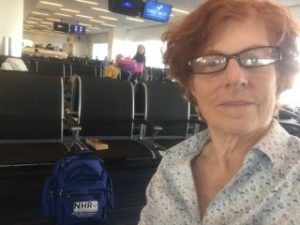
National Heritage Responder Molly O’Guinness Carlson heading to the Caribbean with NHR equipment. Courtesy Molly O’Guinness Carlson.
The Museo de Arte de Puerto Rico also opened its doors to store over 220 artworks and artifacts from a half a dozen institutions until it was safe for the works to return. Some of the institutions that MAPR has assisted include: Santa Catalina Palace (the official residence of the Governor of Puerto Rico), Sacred Heart University, the José M. Lazaro Library at the University of Puerto Rico, Caguas Art Museum, Luis Muñoz Marín Foundation, Ateneo Puertorriqueño, and Casa Roig Museum.
Sometimes museum directors had to take dramatic, not to say creative, steps to save their collections. The director of the Museum of Contemporary Art of Puerto Rico in San Juan, Marianne Ramírez Aponte, described how she had to “hack big, rectangular vents” into their gallery walls to create cross-ventilation to fight the high temperatures and humidity [to prevent mold growth and water damage] until power could be restored.” Due to these astounding efforts the museums lost very little of their art and artifacts.
NGOs: Aid from Abroad and Help on the Ground
Emergency heritage conservation organizations from the United States – groups trained in art and cultural heritage rescue and recovery – donated money or came to lend a hand in Puerto Rico. One of the groups to dispatch assistance to the island was the National Heritage Responders (NHR). Cultural Property News spoke via email with one of NHR’s responders, Molly O’Guinness Carlson, a high school teacher in the Northeast with a background in archaeological conservation and wet-site conservation (think shipwrecks).
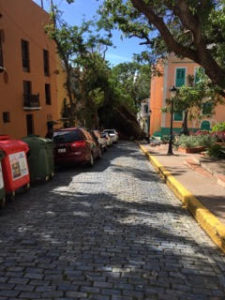
Uprooted tree against a building. Courtesy Molly O’Guiness Carlson.
The National Heritage Responders sent two deployments to Puerto Rico to assist the museums with conserving their collections. The team from NHR that Molly was on arrived in Puerto Rico over 70 days after Hurricane Maria.
This was Molly’s first deployment with NHR, but not her first time in Puerto Rico: “I was thrilled to do so because once as a sailor I went through a hurricane on a square topsail schooner and we got pretty beat up. We limped into Puerto Rico by following a radio direction beacon right under El Morro National Park to the inner harbor. The people of PR took very good care of us and it was great to give something back to them.”
Molly described the herculean efforts of museum staff throughout the island in conserving their collections: “Directors, curators and cultural agency staff were very, very challenged to protect what they curated while without building integrity, security and climate control.
“The people who needed to work in this environment were isolated, not getting trauma help or advice on how to stay safe. They felt helpless yet were trying to carry the responsibility of managing the disaster. Mental exhaustion was very evident, yet they were loyal to their collections and were soldiering on.”
Molly recognized the impact of trauma and described her team’s response to the situation. “Sometimes the best gift we could give was just to listen… to let them tell the story of what they experienced and let them stop being in charge for just a little while… to give them an eddy where they could put down Atlas’s burden.”

Building destroyed by the hurricane. Courtesy Molly O’Guiness Carlson.
“They were isolated and did not know why they were crying at home and did not realize they were having very real trauma reactions. We were the first to hear their story. We were able to acknowledge the exemplary efforts they took before the storms hit… and reassure them that their efforts to mitigate the damage in a system of island-wide chaos and loss of infrastructure were often exactly right.”
(For more about the National Heritage Responders see: EMTs for US Heritage: National Heritage Responders: An Interview with Jessica Unger of the the Foundation of the American Institute for Conservation, Cultural Property News, February 1, 2018)
How Other Museums Can Help
The response of Chicago’s National Museum of Puerto Rican Arts & Culture highlights how museums and cultural centers outside of the Caribbean helped the islands after the disaster. In an interview on Adelante Chicago, museum director Billy Ocasio described the museum’s efforts to help Puerto Rico rebuild. In recognition of their role as community leaders as well as cultural centers, the museum initially partnered with multiple relief organizations to help support over 20 mission trips bringing supplies to all 77 communities in Puerto Rico.

Generator surrounded by rum barrels in the inner courtyard of the building that housed the Museo de las Americas. Courtesy Molly O’Guinness Carlson.
Once the basic needs of the people of Puerto Rico were met, the National Museum of Puerto Rican Arts & Culture began to assess what it could do to help the arts and culture of Puerto Rico. Ocasio said, “at the end of the day we are a Puerto Rican museum and our mission is to preserve the art and the culture and the traditions. So we looked at the creative economy of PR and we found that nothing was going to the creative economy of PR… so we partnered with the government of Puerto Rico through the Institute of Puerto Rican Culture which preserves the art and artifacts.” The Chicago museum opened a brand new gift shop that purchases all its goods directly from Puerto Rican artists. The money thus raised goes back to Puerto Rico to buy more goods from the Puerto Rican artists. Ocasio reports that the gift shop has been wildly successful and is helping to build the creative economy of Puerto Rico.
Focus on Barbuda
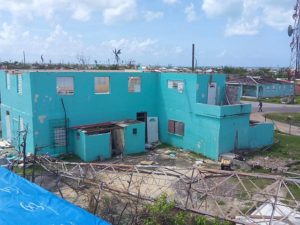
Author: Bennylin, Hurricane Damage in Barbuda. 6 October 2017, [CC BY-SA 4.0 (https://creativecommons.org/licenses/by-sa/4.0)], from Wikimedia Commons.
Barbuda’s recovery has been halting and hampered by ongoing outages and resource shortages. The government’s website states: “Sadly we are not able to regularly update the website on a regular basis since we have been back in Barbuda. Nearly nine months now without electricity, we are still using expensive generators that cost too much to run for more than a few hours and gas is limited and is often rationed or runs out. The internet is slow and is no longer being provided free at the Fisheries building; often there is no signal. Most people have limited phone signal.”
Homes are gradually being repaired but the pace is slow, especially for those in the worst damage categories – still waiting patiently in tents as we approach the next hurricane season.”
We do not yet know what happened to the historical and archeological sites listed on Barbuda’s website. These include the remains of a 19th century castle, as well as an old government building and other early structures from Barbuda’s history.
At the Barbuda Archaeological Research Center, “much of the center’s outdoor equipment and weather station were destroyed,” reported the Science News Staff at Science. One of the Center’s dogs and a horse were killed by debris. Fortunately, the Barbudan staffer at the center and her family survived unscathed, despite minor damage to the main building.
Dr. Sophia Perdikaris, a professor at Brooklyn College in New York City and director of the Barbuda Archaeological Research Center, has been running the Brooklyn College archaeological field school to Barbuda for the past ten years. For a decade, she has worked with a team of local Barbudans studying pre-Columbian human remains on the island. Dr. Perdikaris told the staff at Science last autumn that, “I think I was in tears the entire week,” she says. “[The Barbudans] become like a family; it becomes like a second home.”
At the time of publication, Cultural Property News has been unable to reach Dr. Perdikaris or determine what has become of the Barbuda Archaeological Research Center.
Legislative Jetsam from the Storm
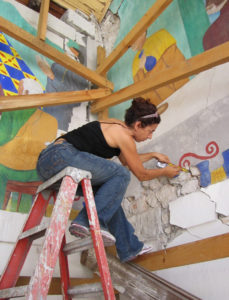
Haiti, 2010. Assessing structural damage and its impact on a wall mural following the 2010 Haitian earthquake. Courtesy Foundation of the American Institute for Conservation.
In addition to the damage sustained by Barbuda’s archaeological sites, the island’s contemporary cultural is undergoing changes incited by Hurricane Irma. Perhaps most significant are intensified challenges to the island’s communal land ownership practices that have been in place since the abolishment of slavery in the 1830s and legalized by the Barbuda Land Act of 2007.
According to Steve Sapienza of the Pulitzer Center in his article Hurricane Irma nearly destroyed Barbuda: will recovery destroy the island’s communal way of life?, the Prime Minister of Barbuda, Gaston Browne, declared an end to communal land ownership in a November 2017 United Nations donor conference in New York. Faced with a $200 million bill to rebuild the island, “he claimed that private land ownership is the only way to secure financing to rebuild Barbuda because collective ownership scares away foreign investors.”
Opposition to deconstruction of communal land ownership was already in the works with legal challenges to the Paradise Found (Project) Act, 2015. Paradise Found Nobu is a $250 million resort project spearheaded by actor Robert DeNiro and investor James Packer. The 2015 Act amended the 2007 Barbuda Land Act to allow developers to lease land beyond the 50-year maximum limit and to dispense with plebiscite approval for large developments – both amendments directly benefiting the resort. The Barbuda People’s Movement (BPM) has challenged the act’s constitutionality, but with so much of the island destroyed, it will be hard for the islanders to turn away from the possibility of foreign investment and increased tourism.
What Comes Next?
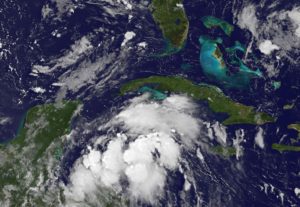
NOAA’s GOES-16 satellite captured this image of Hurricane Maria approaching the Leeward Island on September 18, 2017. As of 11:00 a.m., Maria was a category 3 hurricane located about 60 miles east of of Martinique and moving toward the west-northwest near 10 miles per hour. By NOAA [Public domain], via Wikimedia Commons.
There is no doubt that hurricanes are getting stronger and more destructive. Museums and cultural heritage sites need to know how to protect their staff, collections, and buildings from the danger posed by these storms, and how to recover post-hurricane. Moving forward, museum and institute staffers can look to the experiences of the cultural heritage safe keepers in the Caribbean to learn how to prepare, how to recover, and where to look for aid. The quick response of the wider arts community to the Caribbean crisis is a warming reminder of the sense of comradeship which ought to pervade the international art world. Cultural heritage institutions are essential to communities, even – or perhaps especially – at times of national crisis.
What’s a Museum to Do?
Since the disastrous 2017 hurricane season, more information has been assembled to help arts institutions prepare for a possible event and to seek assistance if disaster should strike.
The American Institute for Conservation of Historic and Artistic Works (AIC) has many resources on its website centered around the four aspects of emergency planning: preparedness, response, recovery and mitigation.
http://www.conservation-us.org/emergencies#.WzF6ay-ZM6g
In the Eye of the Storm: How Federal Funding Rescues Arts and Culture in Times of Disaster, a report produced last year by the Andrew W. Mellon Foundation, explains the many ways art and culture institutions can receive support after a crisis.
https://mellon.org/resources/shared-experiences-blog/eye-of-the-storm/
Preparedness
To help prevent as much damage as possible before disaster strikes, institutions should prepare.
http://www.conservation-us.org/emergencies/emergency-resources/preparedness-resources#.WzF_MS-ZN0s
Response
In case of an emergency, you should know how to respond swiftly and appropriately to work with first responders and emergency managers.
http://www.conservation-us.org/emergencies/emergency-resources/response-resources#.WzF60i-ZM6g
Recovery
Both short term and long term recovery will benefit from having a thoughtful plan in place.
http://www.conservation-us.org/emergencies/emergency-resources/recovery-resources#.WzF67i-ZM6g
Mitigation
Learn from previous events in order to develop strategies for mitigating future damage.
http://www.conservation-us.org/emergencies/emergency-resources/preparedness-resources#.WzF6wi-ZM6g
 Hurricanes Norma, Otis, and Jose. Note Tropical Storm Jose. National Hurricane Center reported as of 4pm EDT Sept. 15, 2017, the storm was located about 360 miles NE of the southeastern Bahamas and 485 miles southwest of Bermuda.By NOAA [Public domain], via Wikimedia Commons
Hurricanes Norma, Otis, and Jose. Note Tropical Storm Jose. National Hurricane Center reported as of 4pm EDT Sept. 15, 2017, the storm was located about 360 miles NE of the southeastern Bahamas and 485 miles southwest of Bermuda.By NOAA [Public domain], via Wikimedia Commons 

